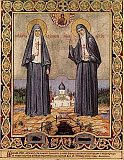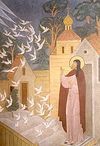

| Previous day | Next day |
| Old Style
July 5
|
Thursday |
New Style
July 18
|
| 5th Week after Pentecost. Tone 3. | No fast.
|
![]() St. Athanasius of Mt. Athos and his six disciples (1000).
St. Athanasius of Mt. Athos and his six disciples (1000). ![]() Uncovering of the relics of St. Sergius of Radonezh (1422).
Uncovering of the relics of St. Sergius of Radonezh (1422).
Martyr Anna, at Rome (304). St. Lampadus, monk, of Irenopolis (10th c.). Sts. Athanasius and Theodosius, of Cherepovets (both ca. 1388), disciples of St. Sergius of Radonezh.
![]() New Martyrs Abbess Elizabeth (Romanova) and Nun Barbara, and those with them: John, Igor, Constantine, Sergius, and Vladimir, princes, and Theodore, at Alapaevsk (1918). New Confessor Agapitus (Taube), monk of Optina Monastery (1936).
New Martyrs Abbess Elizabeth (Romanova) and Nun Barbara, and those with them: John, Igor, Constantine, Sergius, and Vladimir, princes, and Theodore, at Alapaevsk (1918). New Confessor Agapitus (Taube), monk of Optina Monastery (1936).
Hieromartyr Stephen, bishop of Rhegium, disciple of Apostle Paul, and with him Bishop Suerus and the women Agnes, Felicitas, and Perpetua (1st c.). Hieromartyr Athanasius, deacon, of Jerusalem (451). St. Morwenna, patroness of Morwenstow (England) (6th c.). New Martyr Cyprian of Koutloumousiou, Mt. Athos (1679). Synaxis of 23 Saints of Lesbos.
Thoughts for Each Day of the Year
According to the Daily Church Readings from the Word of God
By St. Theophan the Recluse

Thursday. [Rom. 15:17-29; Matt. 12:46-13:3]
For whosoever shall do the will of My Father which is in Heaven, the same is My brother, and sister, and mother. By this the Lord gives us to know that the spiritual kinship which He came to plant and raise up on the earth is not the same as fleshly kinship; although in the form of its relationships, the spiritual is the same as the fleshly. The spiritual also contains fathers and mothers—they are those who give birth to people with the word of truth or the gospel, as the apostle Paul says. And it contains also brothers and sisters—they are those who are born spiritually from one person and grow in one spirit. The connection between [spiritual] relatives is founded on the action of grace. It is not external, not superficial, but as deep and alive as the fleshly connection, only it has its place in another much higher and important sphere. This is why it predominates over the fleshly, and when necessary, it brings the fleshly as a sacrifice to its spiritual interests without regret, in full certainty that this sacrifice is pleasing to God and is required by Him.













